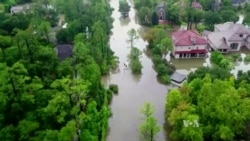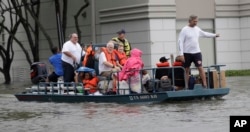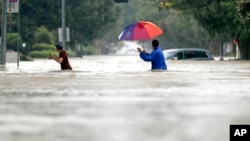The area around Houston, Texas, is getting no relief Monday from historic tropical storm rains that are expected to continue for several more days as rescuers work to reach those trapped by massive floods.
Forecasters expected the storm that came ashore as Hurricane Harvey on Friday night to drop as much as 25 centimeters (10 inches) of new rainfall around Houston overnight, further soaking the fourth largest city in the United States.
The region has already seen as more than 60 centimeters (24 inches) of rain in some places.
U.S. Weather Prediction Center lead forecaster Patrick Burke told VOA another 40 to 60 centimeters of rain is expected through at least Wednesday.
"The message we've been getting out today is that we've never seen a storm like this. We've never seen these rainfall amounts over such a large area, and so the damage is already catastrophic and unfortunately is going to continue to be catastrophic for days to come," Burke said.
Storm moving out but could strengthen
The National Weather Service said the center of the storm was drifting slowly to the southeast early Monday on a path that would take it back out into the Gulf of Mexico sometime Monday and allow for it to possibly strengthen slightly before making landfall again Tuesday.
With the storm bringing band after band of heavy rain over the region, the U.S. Army Corps of Engineers announced early Monday it was beginning the controlled release of water from two reservoirs in order to help prevent them from failing and to reduce the risk of further flooding. The releases will continue for weeks.
Hundreds of rescue operations have taken place throughout the area with crews in helicopters, boats and wading through floodwaters on foot. Volunteers have joined police, fire and medical crews, as well as 3,000 National Guard members.
Texas Governor Greg Abbott said he would order 1,000 more National Guard troops to Houston Monday. He has declared a state of disaster in about one-quarter of the state's counties, allowing the government to speed aid to those areas.
Every major highway into and out of Houston has become a river, and the city's two airports are closed. So far two deaths have been blamed on the storm.
Since the storm's path was plotted and predicted in great detail well before it hit Texas, questions are beginning to be raised about why no mass evacuation was ordered.
WATCH: VOA Spanish service reporter in Houston
“It's impossible not to feel overwhelmed,” VOA's Celia Mendoza said Sunday from Houston. She and other reporters trying to chronicle the tragedy wound up needing rescue themselves as the floods spread.
Houston Mayor Sylvester Turner said it was not possible to overcome logistical obstacles to a large-scale evacuation. He defended his actions at a news conference late Sunday, saying it would have been "crazy" to attempt a mass movement of millions of people on such short notice.
Turner asked where the 6 million residents of Houston and its suburbs could have gone, since the city is by far the biggest population center in that part of Texas, the second largest U.S. state. The mayor said his decision not to order an evacuation was smart and in the best interest of Houstonians.
Advice from emergency officials
For those stranded in flooded parts of the city, emergency officials said no one should seek refuge in the attics of their homes, due to a risk that water rising to record levels would trap them in an enclosed area. The advice to all was simple: climb onto the roof and try to attract attention by waving a white cloth.
WATCH: FEMA official on current operations
Twenty-two aircraft were in the skies over Houston and its surroundings Sunday, trying to keep up with constant calls for help and searching for people marooned atop their homes. Helicopter rescues were common, and authorities had hundreds of boats out searching for flood victims. Some people managed to escape the flooded areas by kayak, canoe or inflatable rafts.
People who thought they might be able to walk to safety through water only waist- or chest-deep in their neighborhoods were warned to resist the urge to test strong currents.
Trump plans Tuesday visit
President Donald Trump will visit the disaster area Tuesday, White House officials said, but only if it is clear that his trip will not disrupt relief efforts.
The latest forecast from the National Hurricane Center warns of “unprecedented” and catastrophic life-threatening floods across southeast Texas. The National Weather Service said “the breadth and intensity of this rainfall is beyond anything experienced before.”
The White House said President Trump led a Cabinet meeting about the storm disaster, and that he expects all federal agencies to stay fully committed to helping state officials in Texas and neighboring Louisiana.
FEMA expects long-term operation
Federal Emergency Management Agency chief Brock Long told CNN television that members of his agency will be involved in operations in storm-damaged areas “for years.” He called the devastation caused by Hurricane Harvey a “landmark event.”
Several Houston-area oil refineries shut down on Sunday as the storm continued. The closures take roughly 12 percent of U.S. fuel-making capacity offline, compounding concerns about fuel shortages and higher gasoline prices.
Harvey was the strongest hurricane to hit the United States mainland in more than a decade.
Celia Mendoza contributed to this report.
In Photos Hurricane Harvey hits Texas:
















